There has been much discussion recently on industry-leading publications about the effectiveness of video on social media.
For example, did you know that video posts on Facebook receive at least 59 percent more engagement than other post types?
Since our 2017 research with Animoto comparing square vs. landscape video, little has been published around the impact of video format on overall video engagement.
Specifically, vertical video vs. square video.
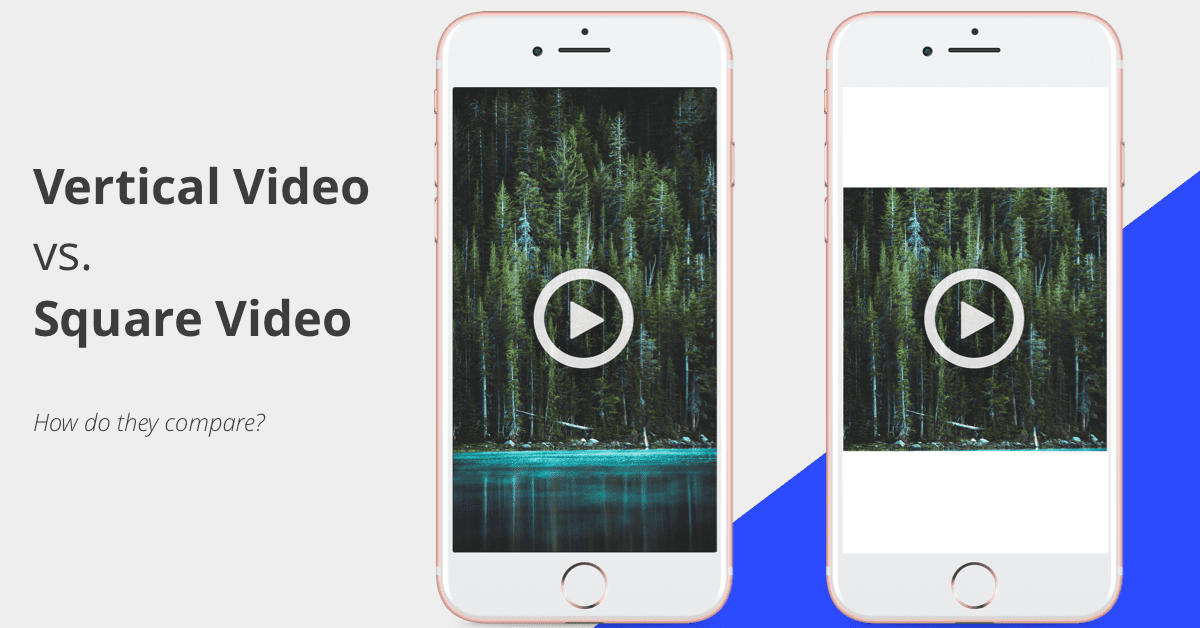
While we know that square video (1:1) results in 30-35 percent more video views and an 80-100 percent increase in engagement compared to landscape video (16:9), we wanted to know how vertical video stacks up on Instagram and Facebook (both within the News Feed and Stories).
Which is why we teamed up with our friends at Animoto once again to test (and test again) the hypothesis that vertical video would perform better than square video on social media.
We were shocked by the results!
Today we’re excited to share our research with you along with several actionable takeaways for marketers looking to improve their social media video marketing results in 2019.
Table of Contents
Below are the full details from our study on everything from our vertical video hypothesis to the surprising results! Here’s a quick look at what we’ll cover:
- The vertical video and mobile hypothesis
- 3 important video marketing takeaways
- Other key video marketing learnings
- Overall vertical video research conclusion
- What’s next for video marketing?
Let’s do this!
The vertical video and mobile hypothesis
This research idea with Animoto all came from one simple statistic: square video takes up 78% more real estate in a person’s mobile newsfeed than does landscape video – making square video more engaging, more effective, and easier to watch.
And since square video outperformed landscape video in almost every category, we hypothesized that vertical video would eclipse square in a brand new study.
But why is video – particularly mobile video – such an important part of your social media strategy?
According to a recent report from Nielsen, U.S. adults are spending 10 hours and 24 minutes per day interacting with media, whether that be watching, listening to, or reading content across all of their devices.
And shockingly, mobile phones (smartphones) alone accounted for 65% of total digital usage, up from 62% in Q1 2018:
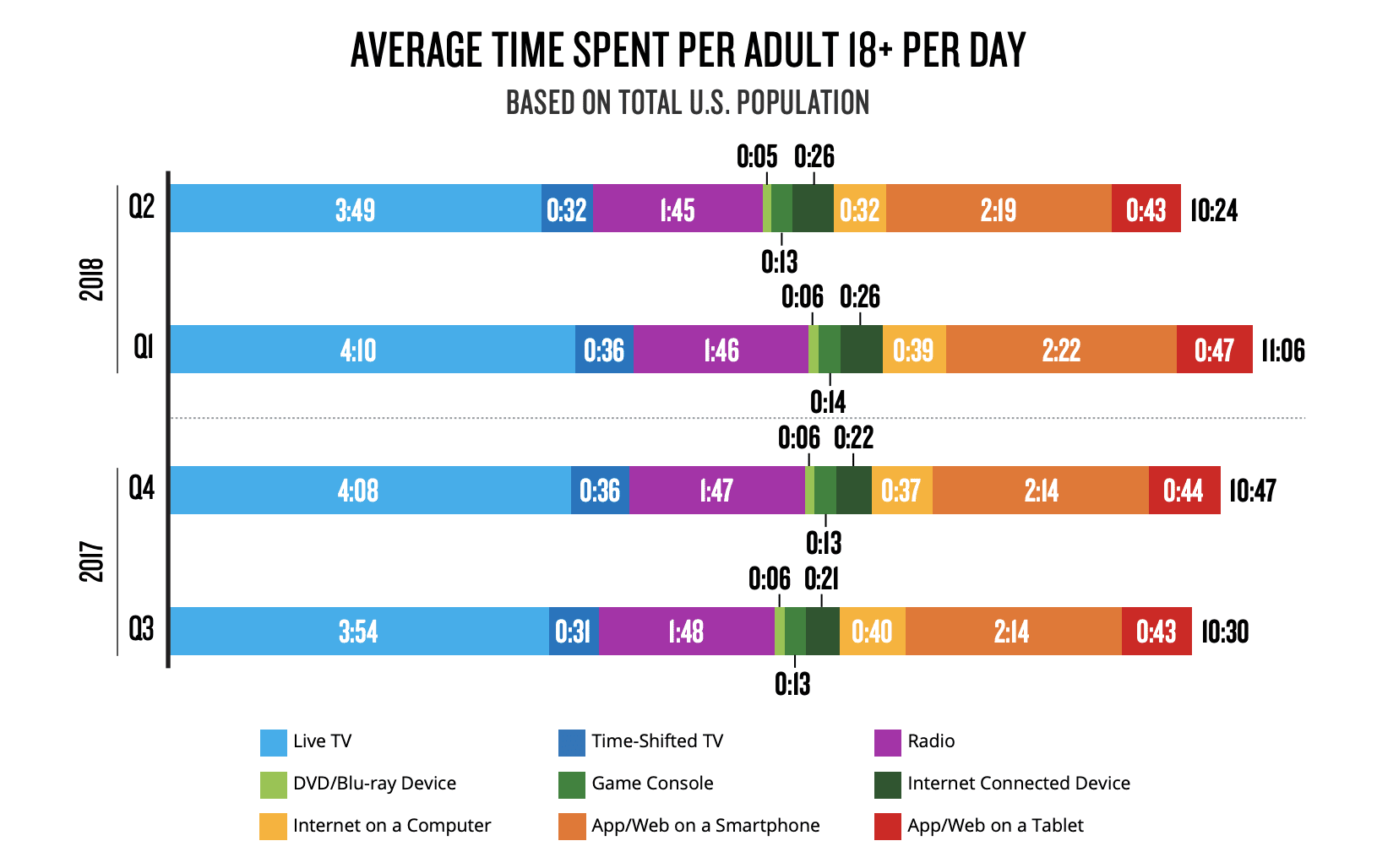
As mobile usage continues to increase year-over-year, our social media and video marketing strategies must evolve along with the expanded use to focus on mobile-first experiences.
Sometimes that’s as simple as formatting the video to fit natively within the platform.
3 important video marketing takeaways
Video is leading the way with social media marketing and so we’re super excited to share this actionable research with you.
By the end of this article, you’ll be equipped with data-backed ideas and insights that you can apply to your own videos today.
But first, a few key takeaways to set the study up!
1. Facebook News Feed: Use vertical video to drive traffic
In all of the experiments we conducted, we consistently found that vertical video outperformed square video within the Facebook News Feed. First let’s look at the cost per click (CPC) comparison:
- Buffer: Cost per click (CPCs) 26 percent less expensive with vertical video
- Animoto: Cost per click (CPCs) 38 percent less expensive with vertical video
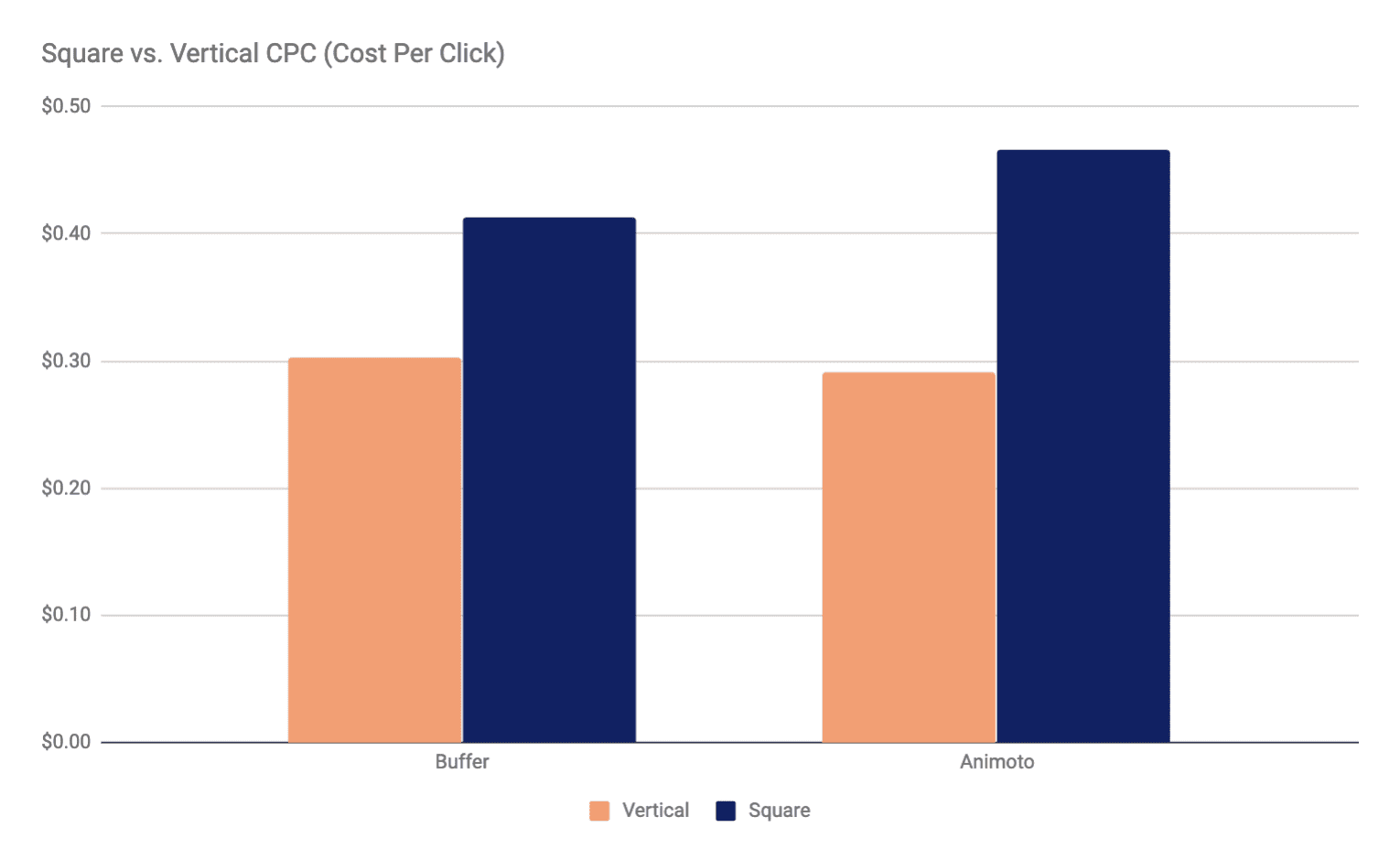
Next, let’s take a look at the cost per view (CPV) comparison:
- Buffer: Cost per view (CPVs) 68 percent less expensive with vertical video
- Animoto: Cost per view (CPVs) 26 percent less expensive with vertical video
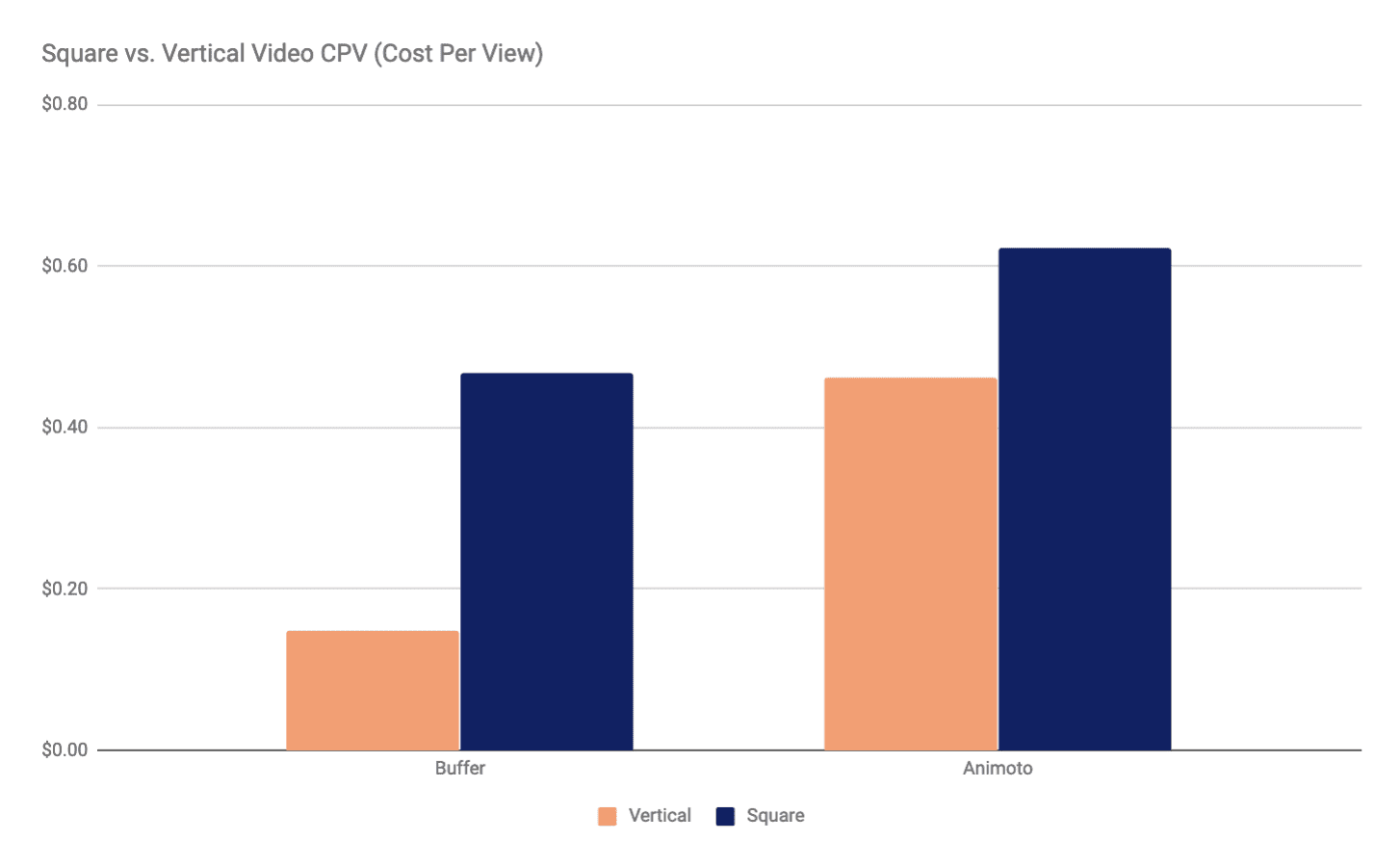
Since the video tests (vertical vs. square) were identical in content, theme, length, headline, caption, and more, it came as quite the surprise that vertical video outperformed square by such a significant margin (as much as 68 percent less expensive in cost per view).
It’s also interesting to note that not only did vertical video outperform square in the Facebook News Feed, but Facebook outperformed Instagram in overall cost per click (CPC) within the feed. An important takeaway for advertisers.
Buffer averaged $0.29 CPC on Facebook and $0.51 CPC on Instagram. Animoto averaged $0.32 CPC on Facebook and $1.31 CPC on Instagram.
2. Instagram Feed vs. Stories: Stories are a great way to inspire action
When looking at the Instagram Feed vs. Stories, it became immediately clear that Instagram Stories are a great way to inspire people to take action. In both the case of Buffer and Animoto, Stories consistently reduced advertising costs in regards to cost per thousand impressions (CPM) and cost per click (CPC):
- Animoto: Stories 57 percent less expensive for CPMs and CPCs than the feed
- Buffer: Stories 50 percent less expensive for CPMs and 30 percent for CPCs than the feed
Cost per click (CPC) data:
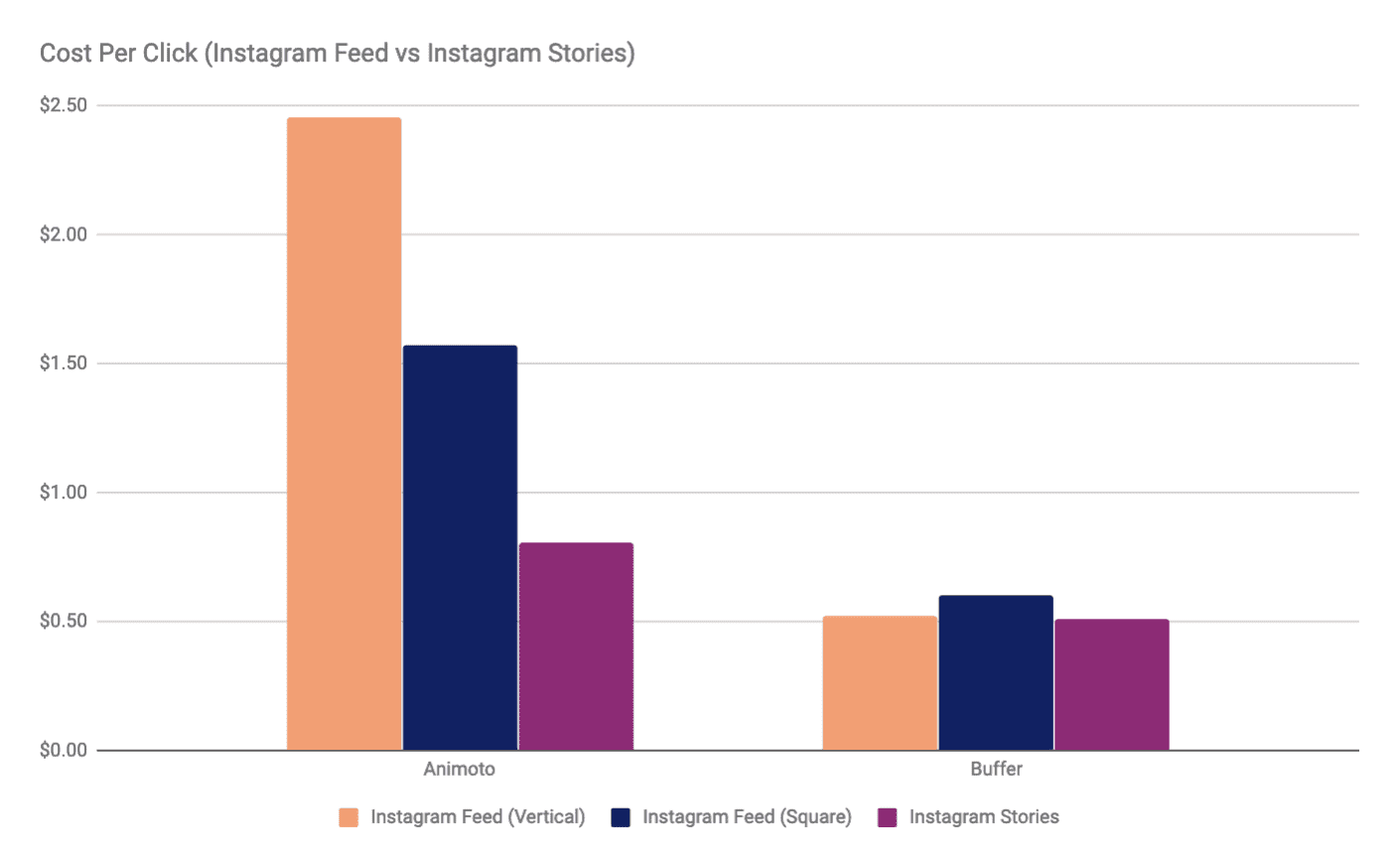
Cost per one thousand impressions (CPM) data:
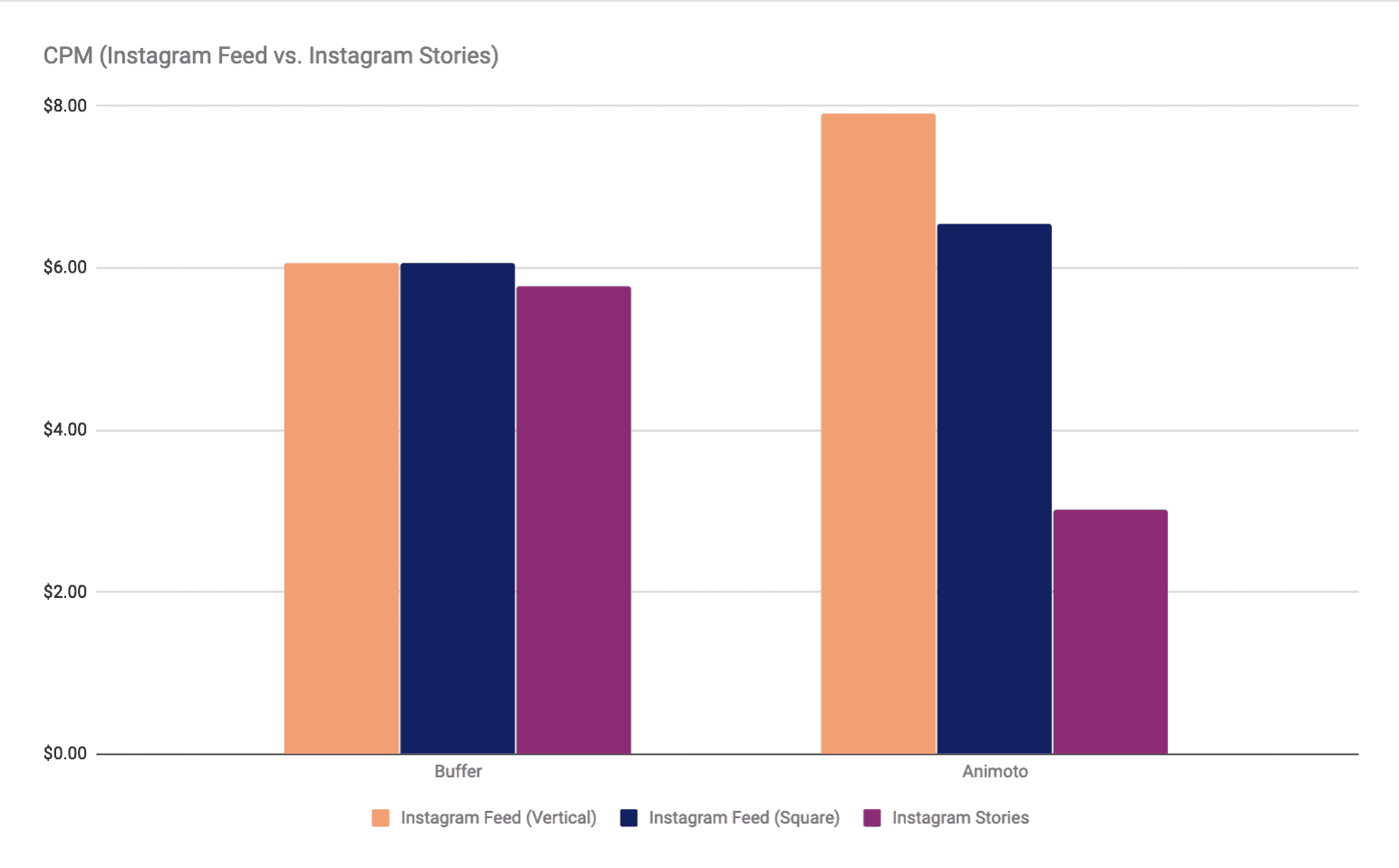
However, it’s important to note that costs actually increased with Stories compared to the feed when measuring cost per view (CPV):
- Animoto: 108 percent more expensive on 3-second CPV and 65 percent more expensive on 50% total watch time CPV
- Buffer: 71 percent more expensive on 3-second CPV and 21 percent more expensive on 50% total watch time CPV
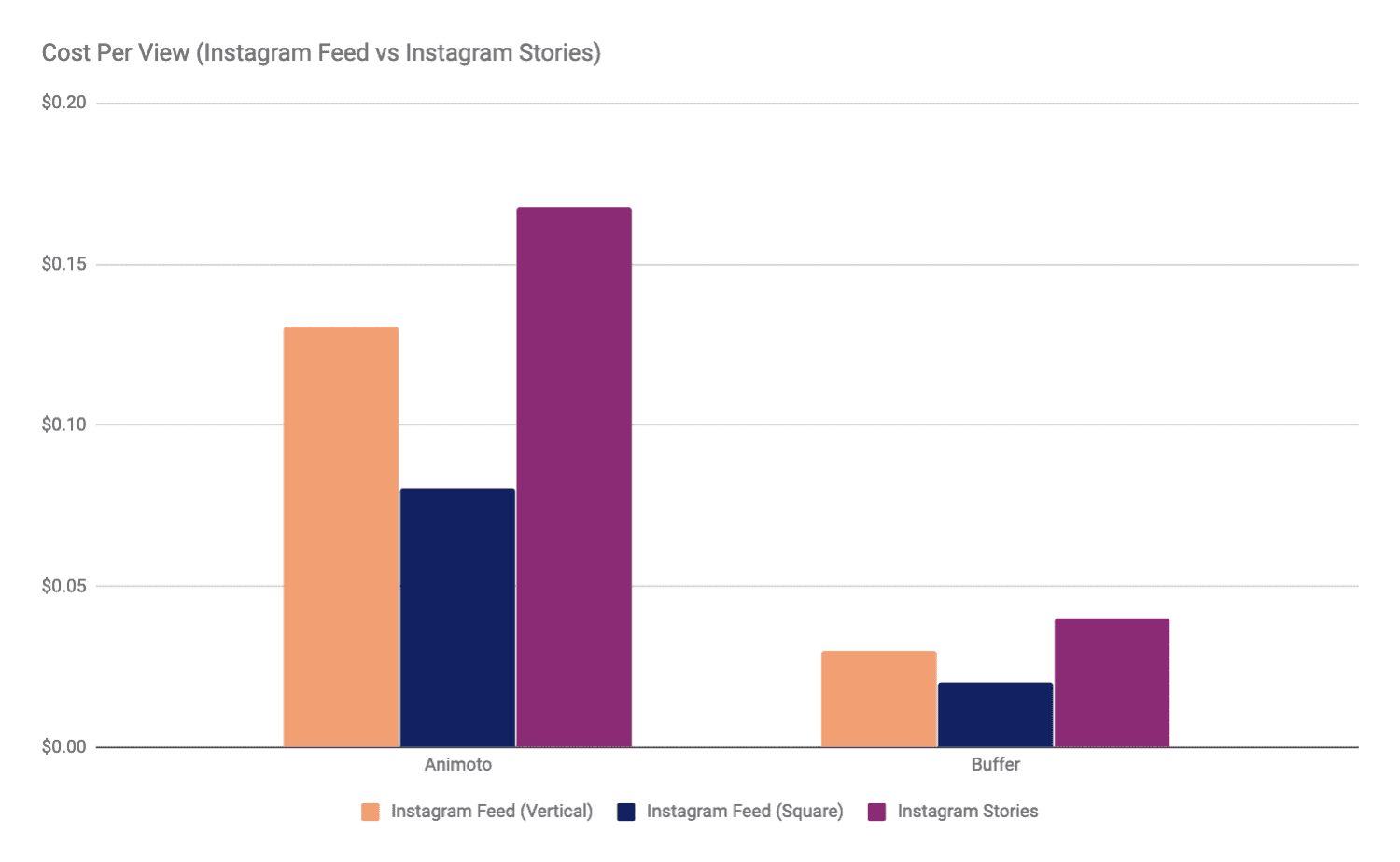
As many of you savvy marketers might have guessed at this point, we witnessed a rise in cost per view as cost per click decreased.
We believe that this is largely due to the fact that it is hard to get people to watch your entire video when they’re too busy taking action such as “swiping up” or clicking on a link.
Overall, Instagram Stories are a great way to get people to take action and a big opportunity for brands to utilize in 2019.
3. Instagram News Feed: Use vertical video to generate engagement
The final big takeaway from our research is that the Instagram Feed is a powerful platform for driving engagement when compared to Facebook (News Feed & Stories) and Instagram Stories… almost too good!
Reversing the Instagram Feed data from takeaway #2, you’ll notice that 3-second CPVs were 91 percent less expensive on average for Buffer and Animoto. In addition, 50 percent total watch time CPVs were 43 percent less expensive on average.
But which format drives more engagement within the Instagram Feed? Turns out it’s vertical video!
- Animoto: Vertical video resulted in 13 percent more 3-second video views and 157 percent more 50% total watch time views
- Buffer: Vertical video resulted in 6 percent more 3-second video views and 187 percent more 50% total watch time views
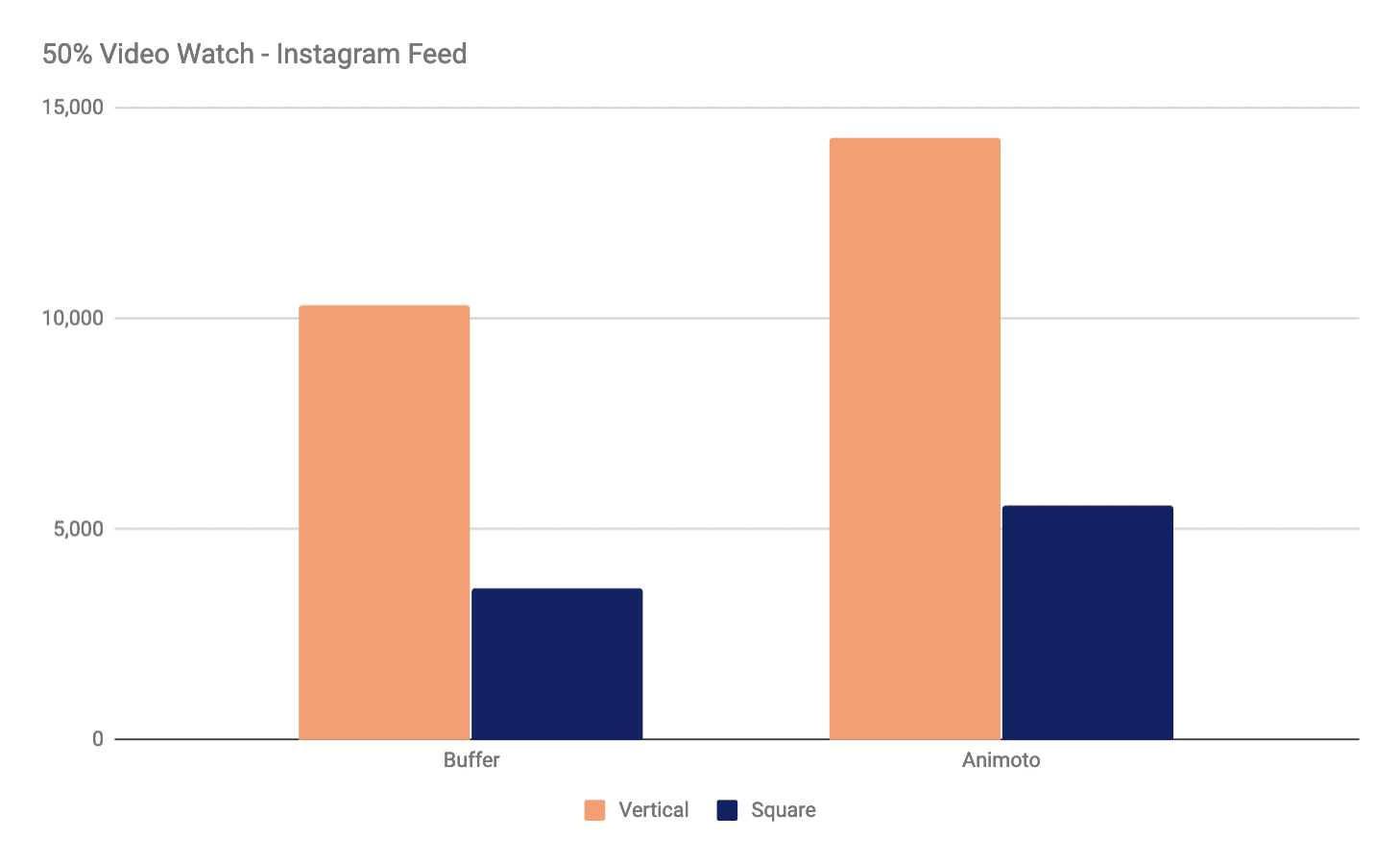
The practical takeaway here is that the Instagram Feed is a great way to boost awareness around your product and generate engagement.
Other key video marketing learnings
In addition to the three key learnings above, our research pointed to some other unexpected takeaways that you might be able to apply to your video marketing strategy.
1. Facebook marketing is alive and well
We’ve discussed the power of Facebook marketing (here and in previous studies) and found that it remains a viable way for brands and businesses to reach target audiences. Particularly, if you’re looking for an inexpensive way to drive traffic to your website.
In all of our tests, we found that Facebook consistently generated a lower CPC than its Instagram counterpart.
While Instagram was the most effective way to generate interactions and engagement in our tests, Facebook emerged as an extremely reliable way to drive traffic.
We’ve seen this hold true over the past two years at Buffer as well. Our most successful social media advertising campaign of all time – a campaign that is still running today – runs on the Facebook News Feed:
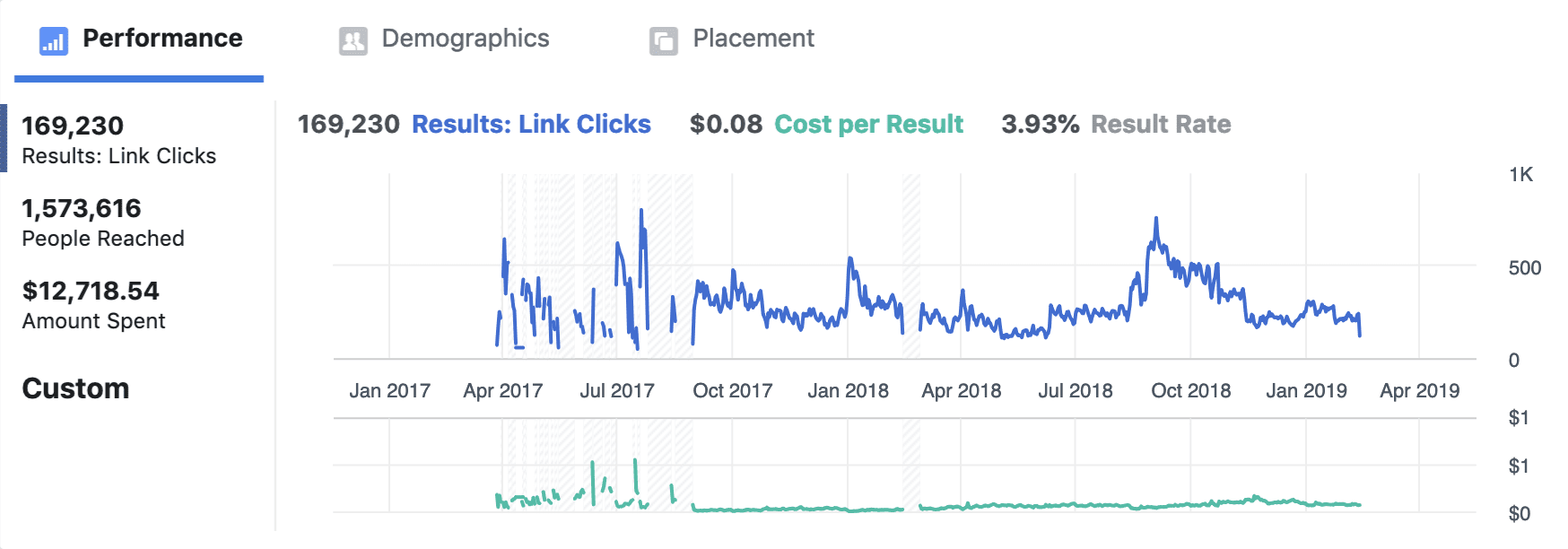
This campaign has generated more than 169,000 link clicks and reached more than 1,500,000 people since launching in April 2017.
The best part is that it’s a super simple ad concept:
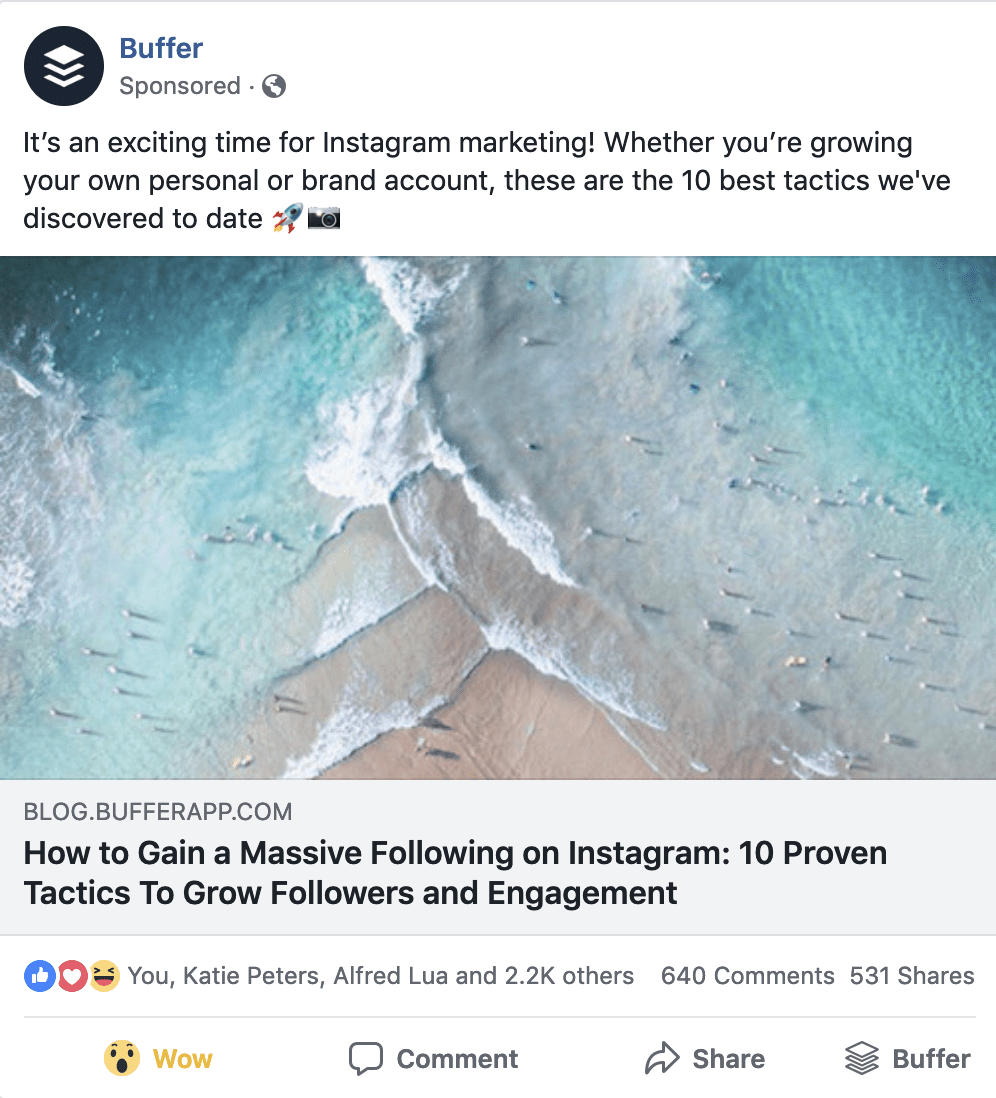
While brands and businesses flock to Instagram in 2019 in search of a new promising advertising platform, look for Facebook to continue to offer a low-cost, action-based alternative.
In terms of what type of content to create for Facebook, remember that, on average, video posts receive at least 59 percent more engagement than other post types.
2. Highly-produced “polished” video content doesn’t always win
One of the more interesting portions of our experiment revolved around testing what we called “organic” vs. “polished” video content.
- Organic videos are what you would imagine as DIY-style. These videos didn’t include any B-roll, special effects, transitions, or other more produced elements. In other words, they looked like they were made by an amateur.
- Polished videos are much more produced. These videos included studio lighting, B-roll, special effects, transitions, and other elements that give them a professional feel.
With our research, we wanted to know if spending more time, resources, and money on producing polished videos actually resulted in greater results than organic DIY videos.
We found that there was no statistically significant difference in the results.
In fact, in many cases, organic DIY videos outperformed polished videos on both Facebook and Instagram.
In collaboration with Animoto, Smarties ran their own experiments to test whether or not highly-produced video ads outperformed organic DIY video ads on Instagram Stories:
Their team found that organic DIY videos resulted in a 50 percent decrease in cost per 10-second video view on their highest performing ad. In their case, unpolished smartphone imagery was up to 2x more effective at capturing their viewer’s attention.
All of this to say that it’s more important to experiment with a variety of video types and formats than it is to work on perfecting a single video. The more video content you publish, the more feedback you’ll receive from your audience, and the quicker you’ll improve.
3. Instagram Stories ads one of the biggest opportunities in 2019
As a result of this experiment, we see Instagram Stories as one of the biggest opportunities for brands and businesses in 2019. It’s why we built a tool called Stories Creator dedicated to helping brands create thumb-stopping Stories content.
And though Instagram Stories now has an incredible 500 million people around the world using the channel on a daily basis, it remains a relatively untapped advertising resource.
“Right now, one of the interesting things about Stories is there’s a benefit to being an early adopter… the pricing is really attractive. And so we think the mix shift to Stories is a big opportunity for us. And it’s going to take time to continue to get advertisers in, but we’re very happy with demand to date,” explained Sheryl Sandberg in Facebook’s recent Q4 earnings call.
We discussed the impact of Stories in this research above, but other big brands such as Bustle, Nike, Square, and more have experienced similar results as a part of their strategies.
Blenders Eyewear, for example, has generated thousands in revenue for their products using Stories ads – leveraging special announcements like a much anticipated restock, flash sale, giveaway and any limited time promos:
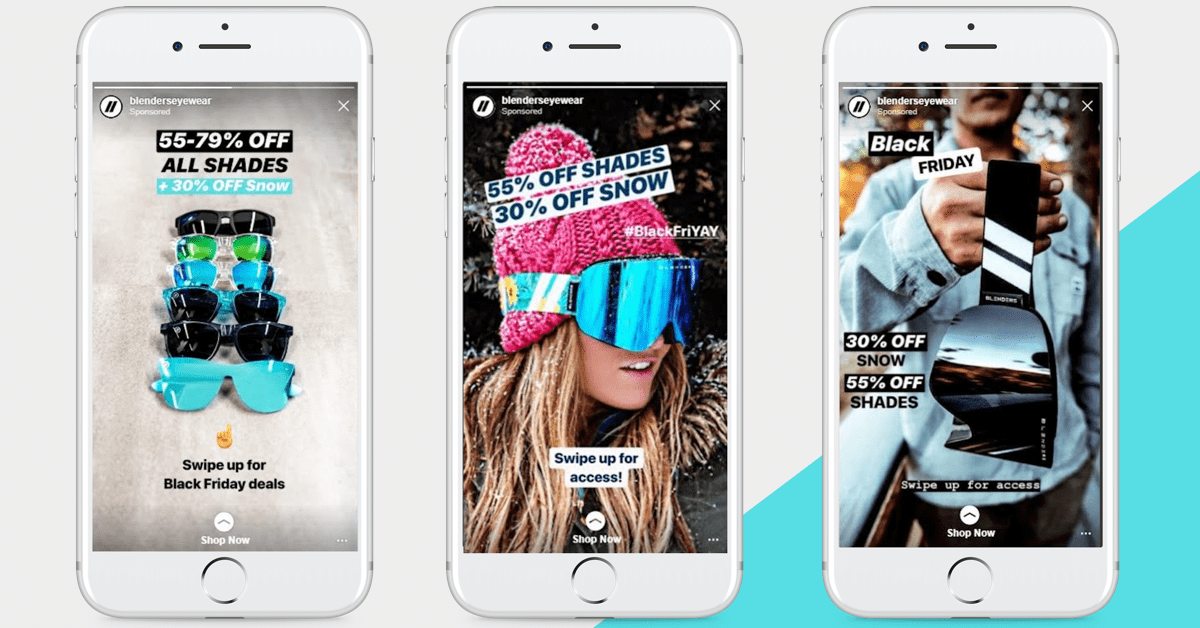
We’ve seen similar results when we use Instagram Stories ads to promote our blog posts and podcast as well. Our Instagram Stories ads cost just $0.06 – $0.12 per click when a typical Facebook feed ad usually costs around $0.30 – $0.60 per click.
Multiply that cost savings by thousands of dollars in ad spend and it’s a no-brainer in choosing Instagram Stories as our primary social media advertising channel in 2019.
Overall vertical video research conclusion
If we were to boil down this research to one key point, it would be that businesses and brands must keep up with mobile-centric video trends if they want to succeed on social media in 2019. A mobile-centric strategy relies heavily on vertical video and creating content that feels native to each platform.
As we mentioned in the beginning, mobile phones alone accounted for 65% of total digital usage in Q2 2018 (up from 62% in Q1 2018) – with that number growing by the day.
Everything from your website to the content you create for social media must focus on the mobile experience. Sheryl Sandberg puts it perfectly when she mentions:
One of the challenges that marketers have is keeping up where consumers are. If you think about our history, people made the shift to mobile before marketers did. And I think one of the successes we’ve had is we made it easier for advertisers to move into a mobile environment.
For marketers, the constant challenge is making it easier for your audience and customers to consume content when and where they want it. Not when and where it’s convenient for you, but when and where it’s convenient for them.
Luckily for us, Facebook and Instagram are making it easier than ever for marketers to provide a mobile-first experience.
It all comes down to whether or not you are willing to be an early adopter, experiment with vertical and square video, try new things, and always be looking to the future of social media.
What’s next for video marketing?
We’re in the midst of a video revolution. The traditional 16:9, landscape format is being replaced by a new, 9:16, vertical format that has fast become the default for video creation and consumption.
Vertical video used to be seen as a mistake —something people do when they forget to turn their phone horizontally while filming — but since the rise of platforms like Instagram Stories, vertical video has taken over and become an innovative way for individuals and businesses to tell stories.
Over one billion people use the vertical video format on Facebook-owned properties like Instagram and WhatsApp alone — and even YouTube has now embraced vertical video on the web and mobile.
Vertical video has changed video production. Anyone can now create incredible video content from a smartphone — no need for cameras, expensive editing suites, it can all be done in the palm of your hand.
Try Buffer for free
190,000+ creators, small businesses, and marketers use Buffer to grow their audiences every month.



